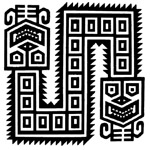Center, Textile Research

PreColumbian Textile Conference VII / Jornadas de Textiles PreColombinos VII (2016)
Date of this Version
10-13-2017
Document Type
Article
Citation
PreColumbian Textile Conference VII / Jornadas de Textiles PreColombinos VII, ed. Lena Bjerregaard and Ann Peters (Lincoln, NE: Zea Books, 2017), pp. 50–67
doi:10.13014/K2GT5KB3
Abstract
En cuevas del actual estado de Guerrero, México, se han encontrado diversos objetos orgánicos como calabazos, cordeles, guaraches, madera, semillas y hojas. Asimismo, se han recuperado fragmentos de textiles que fueron elaborados con distintas técnicas, pigmentos y texturas que dan cuenta de una especialización e intensa actividad económica en tiempos prehispánicos. En el México antiguo los textiles tuvieron múltiples funciones. Fueron muy utilizados como indumentaria de nobles y dioses, formaron parte de rituales y cubrieron objetos sagrados que se guardaron celosamente en templos, palacios y casas de los señores. También tapizaron paredes y se les colocó como doseles, tapetes, colchas, manteles y servilletas. Los textiles eran indicadores de prestigio y jerarquía, sobre todo los elaborados en algodón, ya fueran bordados o pintados. Se usaban en fiestas, ceremonias, matrimonios y posiblemente en rituales de enterramiento. Su valor era tal que se les empleó como un medio de cambio en transacciones comerciales. El presente trabajo se divide en tres partes. Primero daremos un panorama general de los textiles arqueológicos que se han recuperado en el actual estado de Guerrero. Después hablaremos de los materiales procedentes de la región centro-norte de Guerrero, es decir, de cuevas al norte del río Balsas por el rumbo de Teloloapan, Iguala y Cocula. Por último, veremos elaborados diseños de algunos textiles de esta región y su semejanza con telas que la provincia tributaria de Tepecoacuilco debía enviar a México-Tenochtitlan y que fueron representadas en la Matrícula de Tributos y Códice Mendocino del siglo XVI.
The textiles from the State of Guerrero: a survey from an archaeological and ethnohistoric perspective
Pre-Columbian organic objects like gourds, rope, sandals, wood, seeds and leaves have been found in caves in the state of Guerrero, Mexico. Moreover, fragments of textiles manufactured in various techniques, dyes and textures have been recovered, which suggest an intensive degree of specialization and economic activity in pre-Columbian times. In ancient Mexico the textiles had multiple functions. They were much used as clothing by the nobility and the gods, they were part of rituals, and they covered sacred objects that were kept in the temples, palaces and the houses of the nobility. They also covered walls and were used as canopies, mats, bedspreads, mantles and scarves. The textiles indicated prestige and hierarchy, especially the finer cotton textiles, which were embroidered or painted. They were used in fiestas, ceremonies, weddings and probably also funeral rituals. Their value was so great that they were also used as a means of exchange in commercial transactions. This paper is divided in three parts. First I give a general overview of the textiles excavated in Guerrero. Then, I discuss the objects from the northern central region of Guerrero, i.e. from caves north of the river Balsas around Teloloapan, Iguala and Cocula. Finally, I discuss the elaborate designs on the textiles of this region and their likeness to the textiles given by the tributary province of Yepecoacuilco to Mexico-Tenochtitlan, that were represented in Matrícula de Tributos y Códice Mendocino from the XVI century.
Included in
Art and Materials Conservation Commons, Chicana/o Studies Commons, Fiber, Textile, and Weaving Arts Commons, Indigenous Studies Commons, Latina/o Studies Commons, Museum Studies Commons, Other History of Art, Architecture, and Archaeology Commons, Other Languages, Societies, and Cultures Commons


Comments
Copyright © 2017 by the author.